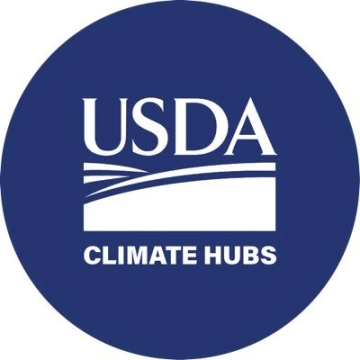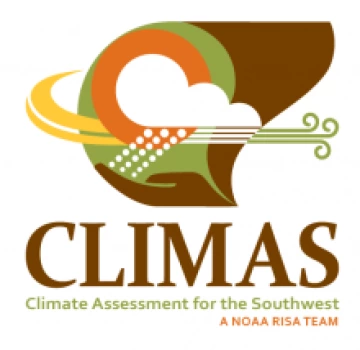< Back to Climate Viticulture Newsletter
Hello, everyone!
This is the November 2025 issue of the Climate Viticulture Newsletter – a quick look at some timely climate topics relevant to wine grape growing in Arizona.
IN THIS ISSUE
- A Recap of October Temperature and Precipitation
- The Outlook for November Temperature and Precipitation
- Heat Accumulation during the Growing Season
- Extra Notes
A Recap of October Temperature and Precipitation
Monthly average temperatures were 1 to 4 °F above the 1991-2020 normal for many locations in northwestern, northeastern, and southeastern Arizona (light orange, orange, and dark orange areas on map). Otherwise, temperatures were mostly near normal (white areas on map). For reference, monthly-average temperatures in October 2024 were more than 5 °F above normal for almost all of the state.
Area-average maximum and minimum temperatures during October 2025 were 78.6 and 51.3 °F for the Sonoita AVA, 79.9 and 50.3 °F for the Verde Valley AVA, and 80.9 and 50.2 °F for the Willcox AVA. Respective October normals are 77.3 and 47.5 °F, 80.2 and 47.0 °F, and 79.9 and 46.8 °F.
Temperature last month ranged between 89.8 and 39.0 °F at the AZMet Bonita station, 88.2 and 41.5 °F at the AZMet Elgin station, and 91.4 and 37.9 °F at the AZMet Willcox Bench station.
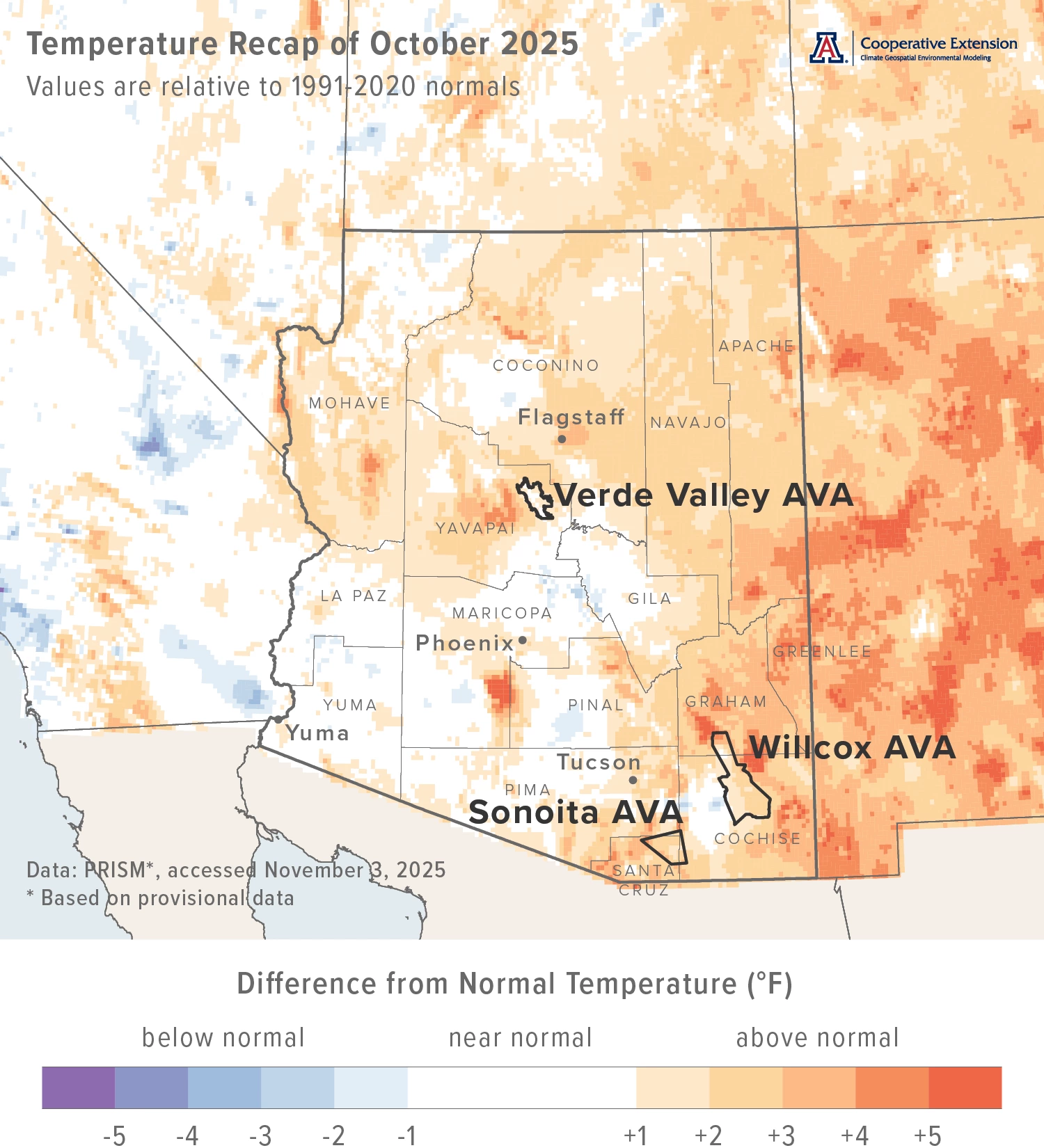
Jeremy Weiss
With remnants from two tropical cyclones, monthly precipitation totals were more than 200 % of normal for a southwest-to-northeast swath across the state (aqua, blue and dark blue areas on map). Most of the rest of Arizona measured amounts between 125 and 200 % of normal (light green, green, and dark green areas on map). Precipitation during October 2024 was less than 50 % of normal for much of the western one-third and southern two-thirds of the state. Only locations in northwestern Arizona recorded near- or above-normal totals.
Area-average total precipitation in October 2025 was 2.02 inches for the Sonoita AVA, 2.37 inches for the Verde Valley AVA, and 1.40 inches for the Willcox AVA. Respective October normals are 0.95, 1.05, and 0.76 inches.
Total precipitation last month was 0.70, 1.71, and 0.63 inches at the AZMet Bonita, Elgin, and Willcox Bench stations, respectively.
Dig further into daily weather summaries for the AZMet Bonita and Willcox Bench stations in the Willcox AVA and the AZMet Elgin station in the Sonoita AVA
Learn more about PRISM climate data

Jeremy Weiss
The Outlook for November Temperature and Precipitation
Temperatures over the course of this month have a moderate increase in chances for being above the 1991-2020 normal for all of Arizona (dark orange area on map). Monthly average temperatures in November 2024 were 1 to 4 °F below normal for much of the state.
Area-average maximum and minimum temperature during November 2024 were 67.7 and 35.0 °F for the Sonoita AVA, 65.6 and 32.5 °F for the Verde Valley AVA, and 67.5 and 32.9 °F for the Willcox AVA. Respective November normals are 67.2 and 38.2 °F, 67.5 and 36.6 °F, and 68.6 and 36.7 °F.
Temperature in November last year ranged between 78.3 and 23.2 °F at the AZMet Bonita station and between 82.4 and 24.1 °F at the AZMet Willcox Bench station.
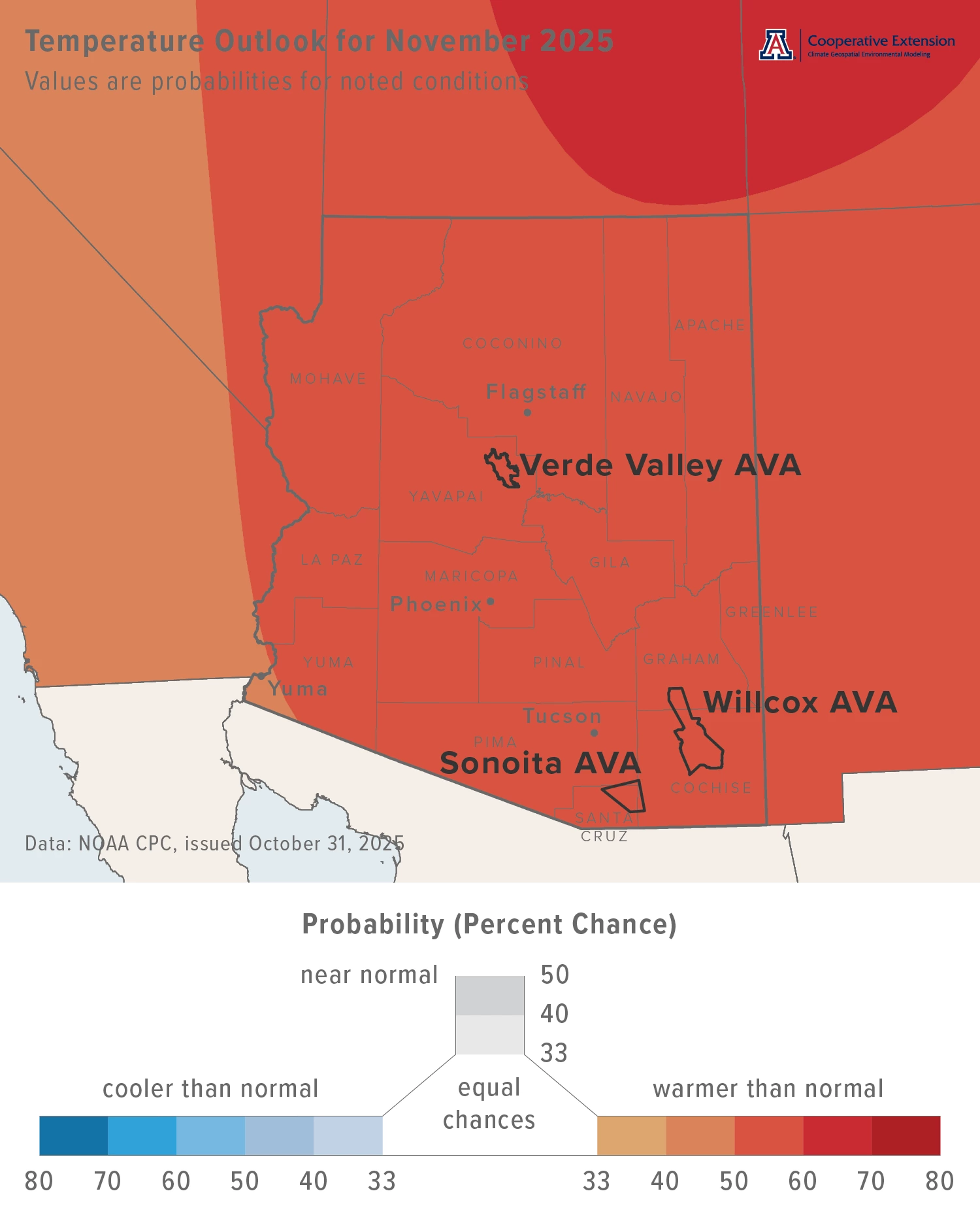
Jeremy Weiss
Precipitation totals for this month have a slight increase in chances for being below normal for all of the state (light and dark tan areas on map). Precipitation during November 2024 was less than 25 % of normal for much of the western half of Arizona, and ranged from 25 % of normal to near normal for the eastern half.
Area-average precipitation totals in November 2024 were 0.65 inches for the Sonoita AVA, 0.16 inches for the Verde Valley AVA, and 0.59 inches for the Willcox AVA. Respective November normals are 0.84, 0.83, and 0.73 inches.
Total precipitation in November last year was 0.32 and 0.59 inches at the AZMet Bonita and Willcox Bench stations, respectively.
To stay informed of long-range temperature and precipitation possibilities beyond the coverage of a standard weather forecast, check in, too, with the six-to-ten-day outlook and eight-to-fourteen-day outlook issued daily by NOAA’s Climate Prediction Center.

Jeremy Weiss
Heat Accumulation during the Growing Season
Having looked at how heat accumulation varies during the year in the February issue, we thought to return to that topic now that the 2025 growing season is in the books. Once again, we’ll use temperature data from the AZMet Willcox Bench station in the Willcox AVA to calculate growing degree hours, a measure we used over the past several months to compare heat accumulation this past growing season with prior ones.
Generally, growing degree hours in 2025 (dark red points and line on graph) follow the seasonal progression of average daily values (black line on graph), initially increasing in April and leveling off in May before decreasing in June as hourly average temperatures more frequently reach into the upper 90s and lower 100s, above the upper threshold of 96.8 °F and when growing degree hours do not accumulate based on this heat accumulation model. Values increase and level off again from July through September before decreasing in October. The up-and-down swings in the 2025 data indicate day-to-day weather and its effect on temperature, variability that multi-year averages tend to tamp down. Daily accumulations of growing degree hours in 2025 fall within the historical range (gray points on graph) with few exceptions, such as in the first half of October when maximum and minimum temperatures in the upper 80s and lower 60s, respectively, were measured over the course of a few days.
Another notable feature in the 2025 data is the multi-day decrease in heat accumulation during early August, with values well below average. Daily maximum temperatures at the AZMet Willcox Bench station were above 100 °F for eight of the first nine days of the month, peaking at 106.3 °F on August 7. As noted above for typical conditions during June, growing degree hours do not accumulate for hourly average temperatures at these values, simulating a stop in vine photosynthesis during those afternoons and perhaps indicating a slowdown in ripening rate.
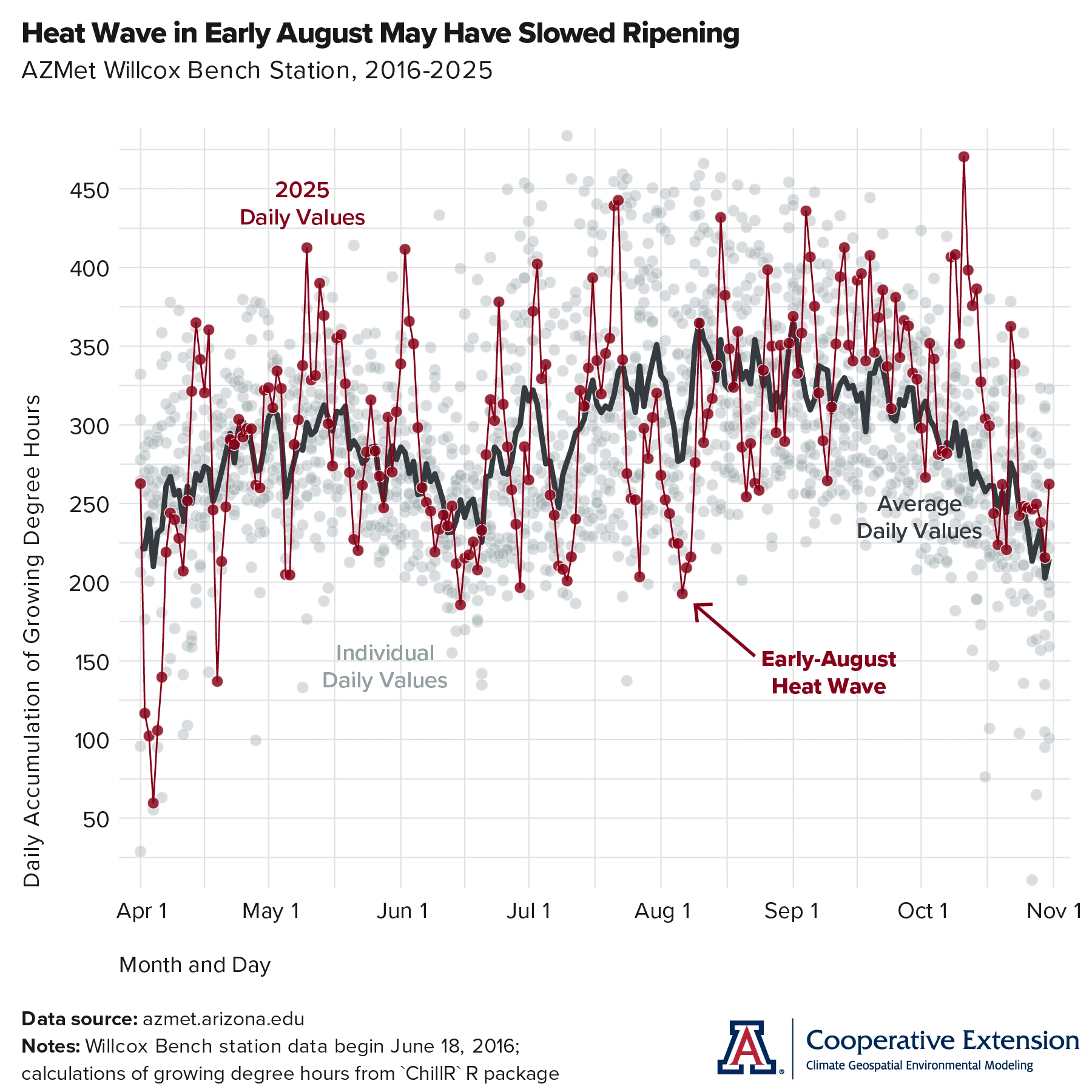
Jeremy Weiss
Extra Notes
The 2026 Arizona Wine Summit and Arizona Wine Growers Association Annual Meeting will take place January 11-13, 2026, at the Yavapai College Verde Valley campus in Clarkdale. Cost to attend is $100. Full registration details are coming soon.
Gradually trending oceanic and atmospheric conditions over the equatorial Pacific Ocean have kept the forecast for October-through-December 2025 in favor of La Niña conditions developing, albeit with a 65 % chance and expectations of being short lived. ENSO-neutral conditions are anticipated to return during the January-through-March 2026 period, with chances at 57 %. Notably, chances of El Niño conditions developing and increasing regional odds for winter precipitation remain below 10 % through the March-through-May 2026 period.
For those of you in southeastern Arizona, including the Sonoita and Willcox AVAs, Cooperative Extension manages an email listserv in coordination with the Tucson forecast office of the National Weather Service to provide information in the days leading up to agriculturally important events, like fall freezes and the occasional winter storm. Please contact us if you'd like to sign up.
And for those of you in north-central and northeastern Arizona, including the Verde Valley AVA, Cooperative Extension also now manages an email listserv in coordination with the Flagstaff forecast office of the National Weather Service to provide similar information for this part of the state. Please contact us if you'd like to sign up.
Undergraduate students in the College of Agriculture and Life Sciences at the University of Arizona are looking for internships with businesses and companies in the viticulture and winery industries. Please contact Danielle Buhrow, Senior Academic Advisor and Graduate Program Coordinator in the Department of Agricultural and Resource Economics, for more information.
Please feel free to give us feedback on this issue of the Climate Viticulture Newsletter, suggestions on what to include more or less often, and ideas for new topics.
Did someone forward you this newsletter? Please contact us to subscribe.
Have a wonderful November!
With current and past support from:

